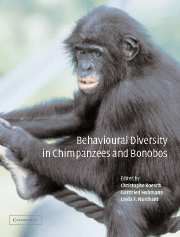Book contents
- Frontmatter
- Contents
- List of contributors
- Preface
- Behavioural Diversity in Pan
- PART I BEHAVIOURAL FLEXIBILITY
- PART II SOCIAL RELATIONS
- INTRODUCTION
- 6 Factors influencing fission–fusion grouping in chimpanzees in the Taï National Park, Côte d'Ivoire
- 7 Ecological and social correlates of chimpanzee party size and composition
- 8 Agonistic relations among Kanyawara chimpanzees
- 9 Relationships of male chimpanzees in the Budongo Forest, Uganda
- 10 Dynamics in social organization of bonobos (Pan paniscus)
- PART III FEMALE STRATEGIES
- PART IV HUNTING AND FOOD SHARING
- PART V GENETIC DIVERSITY
- Index
8 - Agonistic relations among Kanyawara chimpanzees
Published online by Cambridge University Press: 08 February 2010
- Frontmatter
- Contents
- List of contributors
- Preface
- Behavioural Diversity in Pan
- PART I BEHAVIOURAL FLEXIBILITY
- PART II SOCIAL RELATIONS
- INTRODUCTION
- 6 Factors influencing fission–fusion grouping in chimpanzees in the Taï National Park, Côte d'Ivoire
- 7 Ecological and social correlates of chimpanzee party size and composition
- 8 Agonistic relations among Kanyawara chimpanzees
- 9 Relationships of male chimpanzees in the Budongo Forest, Uganda
- 10 Dynamics in social organization of bonobos (Pan paniscus)
- PART III FEMALE STRATEGIES
- PART IV HUNTING AND FOOD SHARING
- PART V GENETIC DIVERSITY
- Index
Summary
INTRODUCTION
Although wild chimpanzees may spend hours resting and grooming peacefully in mixed social groups, and affiliative interactions among them may be more common than agonistic ones, intraspecific aggression is none the less a frequent occurrence in chimpanzee society. Both males and females exhibit an array of aggressive behaviors (from mild threats to lethal attacks) in a variety of contexts (from infant protection to sexual competition) against a range of competitors (from extra-community males to newly immigrated females). Aggression, or merely the threat of aggression, can have a profound impact on individual patterns of ranging and association. For example, female immigrants at Gombe tend to settle in peripheral areas of the range and away from dominant females, where the risk of infanticide may be lower (Williams et al., Chapter 14).
The most dramatic examples of chimpanzee aggression come from observations of intercommunity encounters (e.g. Goodall et al. 1979). Male chimpanzees are philopatric, and they aggressively defend their community range against incursions from neighboring males (Nishida 1979; Goodall 1986; Watts & Mitani 2001). In the course of such defense, they sometimes cooperate to inflict lethal wounds on vulnerable strangers (reviewed in Wrangham 1999). Lethal coalitionary aggression is rare among mammals, having previously been documented as a major source of adult mortality only in wolves (Mech et al. 1998) and humans (van der Dennen 1995). In male chimpanzees, it may be part of a larger strategy to reduce the coalitionary strength of neighboring groups and to expand territorially at their expense (Wrangham 1999).
- Type
- Chapter
- Information
- Behavioural Diversity in Chimpanzees and Bonobos , pp. 112 - 124Publisher: Cambridge University PressPrint publication year: 2002
- 106
- Cited by

